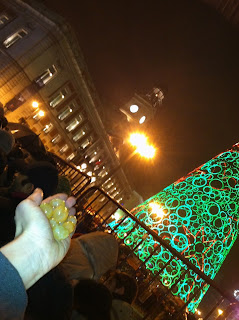August 5, 2010 - Yangtze River, Chongqing, China
~ Claudia Ghandi
Waking at sunrise to watch mornings light illuminate the Qutang Gorge, the most western of the Three Gorges; the scene was draped in a magical mist.
After a typical hit-and-run Chinese breakfast, boarding a smaller boat destined for the Lesser Three Gorges region, which were trickling streams ten years ago and are now expansive tributaries covering drowned villages. Our river guide openly shared his relocation story about owning a home that is now 50 meters underwater. After moving his families personal items to a newly created apartment building up the hill, he boarded the homes windows and locked the doors. All families secure their homes before leaving so items would not float to the surface and damage boats. When we asked our guide his feeling about being forced to move, he stuck to the Communist party line stating, "Life is much better now." Our English speaking guide has a newly built apartment with electricity and running water, a lucrative job in the tourism industry, and his son attends university outside Shanghai.
About 25 years ago, I heard about the Three Gorges Dam for the first time in elementary school. As a 5th grader, we learned about China's need for energy and controlling floods. Our 10 year old minds considered and discussed the proposed project's environmental and cultural impact. Many ancient temples and villages are now underwater. Each student was assigned a native animal from the Yangtze River region to research. I was assigned the then endangered freshwater Baiji Chinese River Dolphin. Two decades ago, researches estimated these mammals would be immediately extinct from damming the Yangtze River waters. This prediction has now proven accurate.
The Lesser Three Gorges region is eerily peaceful. There are no birds or wildlife, just the continuous sound of motorboat engines for harvesting shrimp. We came up with a game called, "Whoever sees the first wild animal wins." After three hours along lush green expanses, we finally saw a couple monkeys, a single butterfly, and three birds. Above a flooded ancient Buddhist site, a new temple was erected two years ago. Still visible, along the gorge cliffs, are carved trails to "hanging coffins" burial sites where important ancestors were placed to rest forever. With rising reservoir waters, these spiritual cliffs are easier to access resulting in "hanging coffins" magically disappearing. To further promote economic growth and hopefully reduce erosion, along the Yangtze's rural shores, China is systematically planting tea trees for rural villagers to harvest and prepare for sale.
Back on the glamorous Victoria Princess, in the early evening, as we navigated closer to the dam, the wind picked up, increasing the wind tunnel effect already created by the gorges. Shortly after a few rain drops fells, thunder and lightening followed. Within minutes the boat swayed in the wind forcing waves from the swollen river below to rock the boat from side-to-side, all while the rains from the heavens pounded our cabin windows. I could not envision a more dramatic Three Gorges Dam approach.
Our Table 17 of westerners has quickly bonded. We easily travel together and find ourselves endlessly laughing on the deck throughout the night. Having never thought of myself as a cruise-type, my father suggested this Yangtze River cruise through the Three Gorges Dam; I'm extremely happy I took his advice.
Today's Victoria Princess Cruise Schedule:
06:45 Morning music call
07:00 Enter Qutang Gorge (first gorge)
07:30 Breakfast served in Dynasty Dining Room
08:30 Change boat to visit Lesser Three Gorges
12:15 Return to boat
12:30 Lunch served in Dynasty Dining Room
13:00 Enter Wu Gorge (second gorge)
18:30 Captain's Farewell Banquet
20:00 Performance
20:30 Travel through Three Gorges Dam locks





